
By Angelo Randaci, Earth’s Ally Horticulturist
Angelo’s passion for plants has led him to explore many areas of horticulture including research, grounds management, technical training, design and nursery management.
Why You Should Build a Bee House
You might be surprised to learn that of the 20,000 known species of bees in the world, only about 2% of them are bumblebees and honeybees. The rest are solitary bees. Native solitary bees differ from honeybees in that they live alone, though they often nest close to one another. Rather than living in a community where social bees work together to raise young, the female solitary bee does all the work of the nesting process alone.
Native solitary bees are responsible for the pollination of an estimated 80% of flowering plants around the world. They are declining due to threats from climate change, loss of habitat, pests, and pathogens, and the misuse of chemical pesticides that are toxic to bees. As a matter of fact, more than 40% of insect pollinators, mostly native bees, are highly threatened.
We can help these remarkable, underappreciated pollinators by providing a suitable environment for them. One of the best ways is to create a pollinator-friendly garden as well as provide a nesting habitat right in our own backyard.
What is a Bee House?
A bee house is a structure, sometimes called a bee or bug hotel, that serves as a nesting site for native solitary bees. Bee houses will not only help increase declining pollinator populations, but they will also increase crop yields of our garden plants and even give us prettier flowers. Here is a plan to make a simple bee house out of wood.
DIY Bee House Materials
- 4 pieces of wood. Be sure to use untreated wood. Mine are about 5×5 inches square but they do not need to be a certain size.
- 1 piece of wood to use as a mounting plate for your bee house. Mine is about 10×10 inches.
- Roofing material. I used a roofing shingle, cut to shape.
- Screws and tacks for the walls and roof.
- Wire or string for the mounting plate.
- Hammer, screwdriver, drill to make pilot holes.

- Paper straws for the tubing. I used paper straws because I won’t need to clean them out at the end of the season. I can just remove the straws, discard them, and replace with new ones.
A note for parents: for another kid-friendly version of the bee house, we also love how 2 Paws Designs used an upcycled plastic bottle and paper grocery bags.
Instructions
Step 1
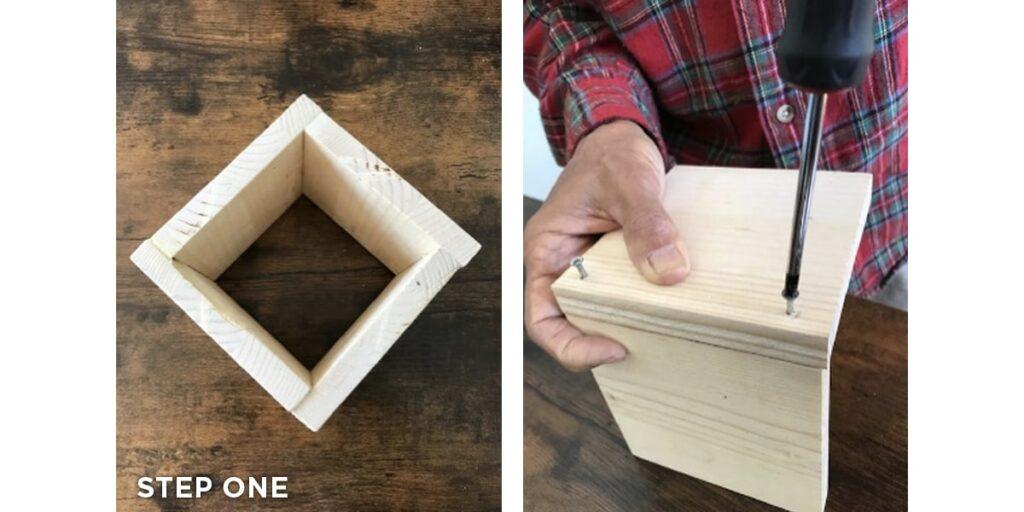
Cut 4 sections of wood for the walls. Attach the sections of wood together using the screws. Join the 4 walls so one end overlaps the other. I pre-drilled pilot holes for each screw first to make it easier to screw the pieces together.
Step 2
Attach the walls to the mounting plate.

You can trace the outline of your walls on the mounting plate as a guide before screwing into position.
Step 3
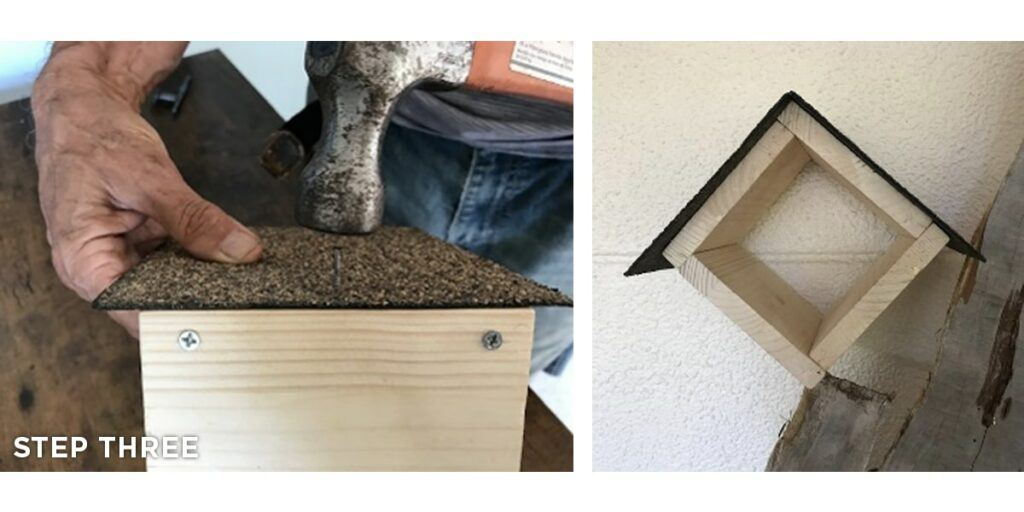
Attach the roof using small tacks or screws. You can paint the bee house if desired or let it weather naturally. I painted a yellow edge on mine to help attract pollinators.
Step 4

Cut the paper straw tubing. Fill the entire space for a snug fit.
Step 5
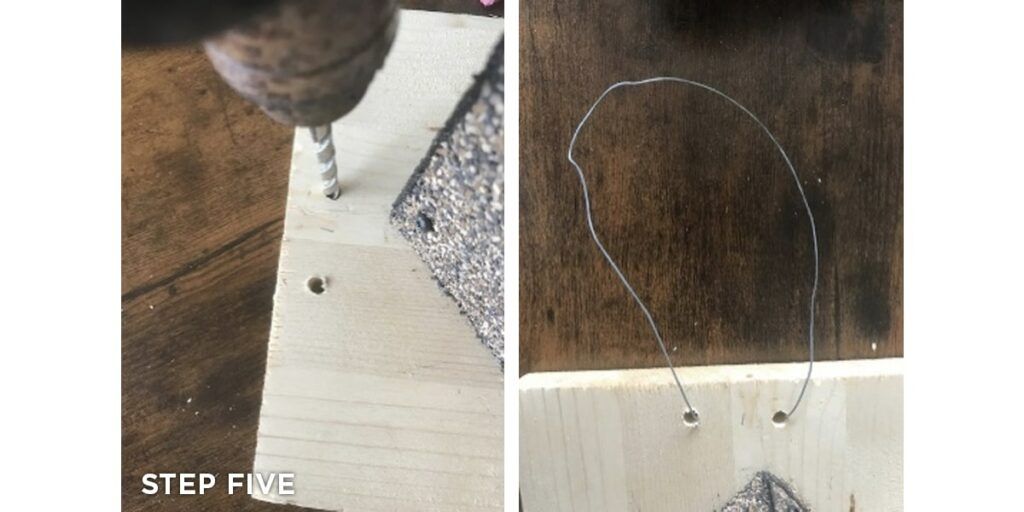
Drill 2 holes in the mounting plate to attach the wire.
How Do you Attract Bees to a Bee House?
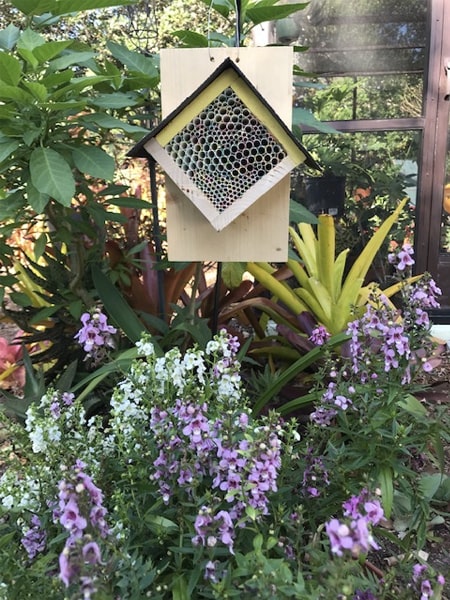
Place your bee house against a solid object in a wind-protected area without vegetation blocking the entrance. The front of the house should face south or southeast to provide the most sun and warmth during morning hours. Many bees search for pollen and nectar within 300 feet of the bee house, so try and place your bee house near pollinating plants.
Maintenance
Nesting materials will need to be cleaned out on an annual basis each year or discarded. Keep an eye out for emerging bees in the spring. The tubes which have been sealed after egg laying will now be open. Once they have emerged, you can clean out the tubes or replace them.
Nesting Materials
Solitary bees will make nests in hollow stalks or holes in soil, sand, clay, or mortar. Natural nesting plant materials include asters, bee balm, reeds, honeysuckle, Joe-Pye weed, raspberries, blackberries, sumac, or any plant with a hollow stem. The bee house can include a mixture of tubes in different sizes using different materials. While solitary bees make nests in hollow stalks of reeds and twigs, your bee house can be made from any materials that provide shelter and protection. These include wood, recycled plastic bottles, coffee cans, or even bundled cardboard tubes, as well as paper straws.
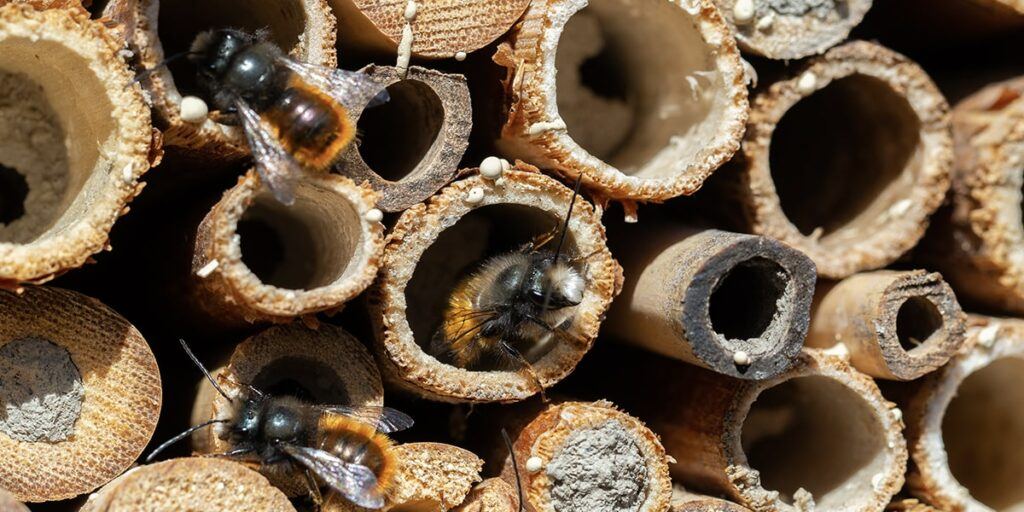
Mason bees nesting in bamboo canes in spring. The entrance is sealed after eggs are laid.
Additional Tips and Pollinator Garden Notes
Plant a diversity of pollen and nectar sources native to your area that bloom throughout your growing season. This will increase habitat for native bees. Include native plants and native pollinators. Many native bee species need to provide their young with pollen from native plants, so including natives will increase the diversity of native bee species.
Provide a source of clean water and mud, which is used as a nesting material by some bee species. You can also provide nesting habitat for native bees by leaving fall debris in your garden beds and waiting for spring to do your garden cleanup. Solitary bees and other beneficial insects often spend winter months protected among garden debris. Some species of butterflies and moths will spend the winter in the layer of dead plant material as well.
In your garden, avoid using conventional pesticides and consider Bee Safe® alternatives, like Earth’s Ally. Always read pesticide labels and use formulas that are proven safe and effective. Limit applications to early morning or evening hours when bees are not actively foraging.
We’d love to hear how Earth’s Ally is helping you grow healthy pollinator gardens. Share your experience with our bee safe formulas and stay connected with the #EarthsAlly community on Facebook, Instagram and Twitter for access to our latest blog posts, giveaways and exclusive promotions.
